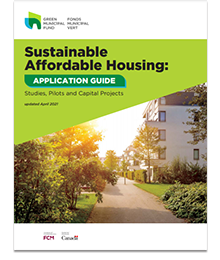These guides outline everything you need to know about applying for GMF funding. Each GMF funding initiative has a dedicated application guide. Find the appropriate guide below for your funding application submission. Then, check out our sample letters for suggestions on how to reach out to your provincial or territorial government and provide details on funding sources in your GMF funding application.
- Sustainable Municipal Buildings
This guide outlines everything you should know about applying for GMF funding under the Sustainable Municipal Buildings offer. It contains application instructions, information about how your project will be evaluated and tips for completing a successful application.
Read the guide
- Community Energy Systems
This guide outlines everything you should know about applying for GMF funding under the Community Energy Systems offer. It contains application instructions, information about how your project will be evaluated and tips for completing a successful application.
Read the guide
- Municipal Fleet Electrification
This guide outlines everything you should know about applying for GMF funding under the Municipal Fleet Electrification offer. It contains application instructions, information about how your project will be evaluated and tips for completing a successful application.
Read the guide
- Organic Waste-to-Energy
This guide outlines everything you should know about applying for GMF funding under the Organic Waste-to-Energy offer. It contains application instructions, information about how your project will be evaluated and tips for completing a successful application.
Read the guide
- Net-Zero Transformation
This guide outlines everything you should know about applying for GMF funding under the Net-Zero Transformation offer. It contains application instructions, information about how your project will be evaluated and tips for completing a successful application.
Read the guide
- Community Efficiency Financing
This guide outlines everything you need to know about applying for GMF’s Community Efficiency Financing (CEF) funding, a $300 million initiative that helps municipalities deliver energy financing programs for low-rise residential properties. The guide contains detailed application instructions, including forms, eligible programs, required supporting documents, and the stages of application assessment and evaluation criteria.
Read the CEF application guide
- Sustainable Affordable Housing
This document outlines everything you should know about applying for GMF’s Sustainable Affordable Housing (SAH) funding, a $300 million initiative that offers support to local affordable housing providers – including municipal, not-for-profit organizations and housing co-ops – to retrofit existing affordable housing units, or construct energy efficient new builds that emit lower GHG emissions. The guide contains detailed application instructions, including forms, project eligibility, required energy and affordability thresholds, and the stages of application assessment and evaluation criteria.
Read the SAH application guide
- Community Buildings Retrofit
This guide outlines everything you need to know about applying for CBR funding, an initiative that supports local governments and not-for-profit organizations in retrofitting public buildings to improve energy performance, lower operating and maintenance costs, and transition to cleaner energy solutions over time. The guide contains detailed application instructions, including forms, eligible projects, greenhouse gas emissions reduction requirements, required supporting documents, and the stages of application assessment and eligibility criteria.
Read the CBR application guide
- Tree planting funding
This guide outlines everything you should know about applying for GMF’s Tree planting funding, offered through GMF’s Growing Canada’s Community Canopies (GCCC) initiative. Developed with small, rural, and remote communities in mind, tree planting funding will support the accessible, ambitious, resilient, and equitable expansion of community tree canopies.
The guide contains detailed application instructions, including details of the funding and how your application will be evaluated, glossary of key terms, summary of required supporting documents, and templates for council resolution.
Funding available: starting Spring/Summer 2025.
- Adaptation funding
This guide details the application approach for Adaptation in Action feasibility studies and implementation projects, offered through GMF’s Local Leadership for Climate Adaptation initiative. This funding supports municipal projects that deliver immediate reductions in the risks posed by climate change impacts, with a particular emphasis on supporting equity-deserving and marginalized communities.
The guide contains detailed application instructions, including details of the funding and how your application will be evaluated, glossary of key terms, summary of required supporting documents, and templates for council resolution.
Read the Adaptation in Action funding application guide.
- Sample letter: confirming provincial/territorial government consultation
Consultation between the lead funding applicant and the government of the province or territory in which the project is located is a requirement when applying for GMF funding, except for municipal governments in Quebec. Use this sample letter template to reach out to your provincial or territorial government and include it in your funding application as proof that the consultation has taken place.
Read the sample letter template
- Sample letter: attestation for flood exposure
Use this sample letter to certify that your new infrastructure asset is built outside the current 100-year floodplain of the most recent floodplain map and/or is protected by permanent structural defenses such as a berm, dike or levee, designed to mitigate flood damage during 100-year or greater flood return interval events. This is required in applications to funding under the Sustainable Municipal Buildings, Community Energy Systems, Municipal Fleet Electrification, Organic Waste-to-Energy and Net-Zero Transformation offers.
Read the sample letter template
- Sample: template for council resolution
Use this template to format a council resolution to include in your application to funding under the Sustainable Municipal Buildings, Community Energy Systems, Municipal Fleet Electrification, Organic Waste-to-Energy and Net-Zero Transformation offers.
Read the template
- Sample letter: confirming project funding sources
Each organization contributing to a GMF-funded project, including the lead municipality, must submit a letter confirming specific contributions to the project. Use this sample letter template when providing details on funding sources in your GMF funding application.
Read the sample letter template












